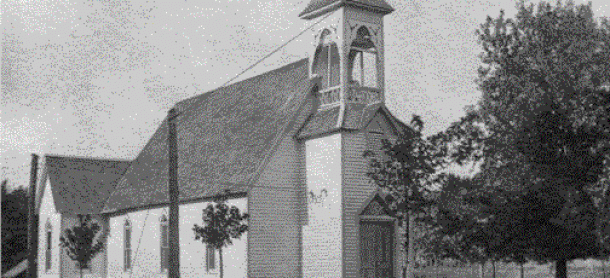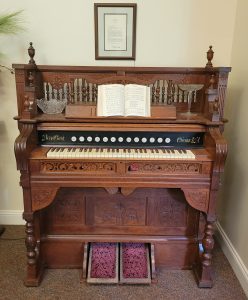Three women, who raised money by sewing carpet rags, founded Saint Paul’s Episcopal Church in 1879. It took Elizabeth Whiting, Belle Jones, and Bessie Gattrell seven years to collect enough money to turn those rags into the riches of a sacred space where 21st-century worshipers still gather today.
It was common at that time for women to take the lead in providing civilized aspects of community life, such as schools and churches. But in this case, they were completely in charge. They chose the plans, signed the contracts, oversaw the construction, paid the bills, and gave the note for the deferred payment.

Needing land to build, they approached William B. Howard, the founder of Lee’s Summit. Howard realized that churches played a crucial role in growing a community. They provided a semblance of civilization and a place to secure the values and lifestyles that many people had left behind in the East. Howard, who donated land for many area churches, provided the site for Saint Paul’s on July 16, 1884, where Green and Grand streets merged with Fifth Street. Lee’s Summit already was growing, largely because of the nearby Southern Pacific Railroad tracks.
The Reverend Frederick B. Scheetz, a former railroad surveyor, designed the church and donated the plans. He also donated plans for Episcopal churches in Butler, Saint James, and Monroe City, Missouri. The Missouri clergyman’s designs were simple, functional, manageable in execution, and yet sufficiently “church-like” to fulfill the spiritual needs of a house of worship.
Fellow townspeople of all denominations contributed toward construction, as did friends and relatives from near and far.
A news article of the day reported:
“Four years ago, five ladies began by forming a sewing society, and each gave five cents. This was the starting point of the church fund. Since then, it has steadily increased. The ladies held festivals when they could, took in sewing, and when there was none to be had, they sewed carpet rags and sold them. Some called it the carpet rag church. It seemed impossible that they should build yet now they have the most handsome church in town, and have great pride and comfort in it. The contractor was an honest man, and his work was constantly supervised by the ladies. The consequence is a strongly built, neat, and tasteful building.”
August 15, 1884, edition of Church News described the building this way:
“They have let the contract for the erection of a frame church in Lee’s Summit, 40 x 24 feet and a vestibule 8 x 10 feet, 12-foot sides and 28 feet to the apex of the roof, with a belfry over the vestibule. It is to be ceiled inside, and have stained glass windows. The lot was given on which it is built. The cost of the building is to be $1,060. The business of collecting the money, making the contract, and superintending the construction is in the hands of some very energetic and capable ladies.“
Spiritual leadership for building Saint Paul’s came from the Reverend. J. W. Dunn, rector of Trinity Episcopal Church in nearby Independence.

In November 1884, the Right Reverend Charles Robertson, Bishop of the Diocese of Missouri, offered services for the first time in the new church during his yearly visit to Lee’s Summit. Construction had been completed only a month or two earlier, and the church still lacked pews. At the time, the Church News reported that the building cost a little over $1,100 with a debt of $200. Five years later, on September 8, 1889, the Right Reverend Daniel Tuttle, Bishop of the Diocese of Missouri, consecrated the building and stated that it was cleared of debt.
Just as its first members needed a place to worship, so today Saint Paul’s is a house of worship and prayer, a refuge, a sanctuary – not for escape, but for renewal, to enrich and sustain our lives. It is the people gathered by God’s Holy Spirit and love that are Saint Paul’s strength.
Enjoy more vintage views of St. Paul’s Episcopal Church below.





Click on the below links for more St. Paul’s history.
St. Paul’s Episcopal Church History
Undercroft of St. Paul’s Church
